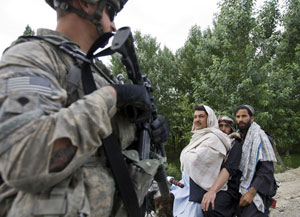(lead article)
U.S. generals seek to
shore up Afghan war
Imperialist armies seen as occupiers

|
|
Reuters/Shamil Zhumatov
|
|
U.S. soldier and Afghanis meet during U.S. “road clearance” patrol in Molahel village in Afghanistan’s Wardak province July 4.
|
BY SETH GALINSKY
An assessment by the U.S. government’s top general in Afghanistan August 30 calls for sending more troops to the war that has raged on now for eight years.
It proposes a profound shift in strategy, drawing on counterinsurgency lessons from the Iraq war and the ongoing transformation of the U.S. military aimed at developing a more effective force to fight the kind of wars the U.S. rulers will increasingly face.
In the report Gen. Stanley McChrystal says that the U.S. military must change its strategy—to what he calls an “integrated civilian-military counterinsurgency campaign”—or it will risk losing, no matter how many more troops are sent there.
A censored version of the document was released by the Pentagon and posted on the Washington Post Web site September 20. It leaves open how many troops should be sent.
“Resources will not win this war, but under-resourcing could lose it,” McChrystal writes in the report. “Resources” mostly means troops but also weapons and civilian personnel to back up the U.S.-led operations.
According to McChrystal, there are three main insurgent groups: the Quetta Shura Taliban, led by Mullah Omar; the Haqqani Network, which he says has ties to al-Qaeda; and the Hezb-e Islami, headed by Gulbuddin Hekmatyar.
Although all three often work together, they have competing interests and no unified command structure. They are mostly based among Pashtuns, who make up 42 percent of the population.
The document states that the Quetta Shura Taliban has attracted some “popular support” for their “shadow” government. It sets up Islamic religious courts called sharia courts in areas it controls or contests with U.S. forces; levies taxes; appoints its own governors for most provinces; and has established “ombudsmen” who investigate charges of abuse of power by its own delegates and removes those found guilty.
The group is also attractive because it portrays itself as fighting against a corrupt U.S.-backed government and protecting Afghans and Muslims from “foreign encroachment,” the assessment notes.
U.S. troops and their allies must avoid being seen as an “occupying army,” McChrystal says. Towards this end he adds, “Key personnel in ISAF (International Security Assistance Force, the name of the U.S-led military coalition in Afghanistan) must receive training in local languages.”
Civilian casualties and “collateral damage” to homes caused by the coalition forces, along with the “shortcomings” of the Afghan government have “severely damaged ISAF’s legitimacy,” the report notes.
The report says that the U.S. forces have not been adequately carrying out counterinsurgency doctrine. To do that they need to root out corruption in the Afghan government, promote “good governance,” enact “justice sector reform,” go after opium traffickers, and get some development projects going.
The report spells out the shift under way to increase troops in more heavily populated areas as part of a “clear, hold, and build” strategy that will be combined with a more centralized command structure.
According to the September 22 Post, U.S. troops have already pulled out of some sparsely populated areas to be redeployed in larger towns. In the Konar River valley, Washington is spending tens of millions of dollars to pave the valley’s main road.
U.S. military officials are also trying to split Taliban forces. In Nurestan, a province that borders Pakistan, they sent a letter to Taliban leader Mullah Sadiq, asking for his “guidance in developing a plan that will improve security and development” in the area.
The same day the assessment was released by the Pentagon, John King interviewed President Barack Obama on CNN. Obama said that he had not yet made a decision on sending more troops. First, he said, he wants to make sure Washington is “pursuing the right strategy.” Once he has “clarity from the commanders on the ground” he will then ask “how do we resource” the strategy?
Alluding to polls showing that a majority in the United States are against the war, Obama said he was “not going to be driven by the politics of the moment.”
The September 22 Wall Street Journal quotes a senior military official who notes that since taking office Obama has “done everything he’s been asked by the Pentagon.”
McChrystal’s request for troops is already prepared, the Journal says, but has not yet been officially turned in. In it he reportedly could ask for up to 40,000 additional U.S. troops, which would bring the total to more than 100,000 for the first time since the war began.
Related articles:
U.S. shift on missile ‘shield’ aims at Iran
The real nuclear arms threat
Washington conducts strike against Islamists in Somalia
| 


